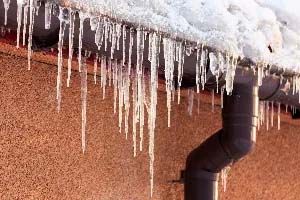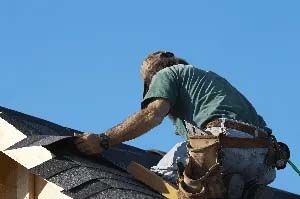What Every Homeowner Should Know About Ice Dams
What Every Homeowner Should Know About Ice Dams

Ice dams occur when the temperature dips below freezing and snow falls, so ice dams are a common problem in cold weather climates. As a homeowner, it's important to know what causes an ice dam and how you can prevent one from occurring on the edges of your roof.
Ice Dams Are Caused by Hot Spots
Ice dams occur as a result of hot spots on a roof. These hot spots are caused by hot air trapped in the attic. When hot spots form, they cause snow on the peaks of the roof to melt. Meanwhile, snow located over the cooler parts of the roof (typically around the eaves) will stay frozen.
When the melting snow reaches the colder parts of the roof, the water refreezes into ice. This thawing and freezing can cause ice to build up on the edge of the roof. As the ice builds, it can back up under the shingles and onto the sheathing. When the ice finally thaws, this can cause leakage and water damage.
Icicles Are a Symptom of Ice Dams
As ice backs up under the shingles of the roof, it can also drip into the gutters and over the edge of the gutters, creating icicles. Clogged gutters can be especially problematic in winter because they can contribute to an ice dam problem.
Other symptoms of an ice dam may include:
· Uneven melting of snow on the roof
· Water damage that occurs after a thaw but not after a heavy rain
· Water leaks in the walls of the home
· Ice that clings to the exterior walls of the house
· Water that seeps into the home through the doorways and windows
If you notice any of these problems on your property, this is a likely sign of an ice dam.
You Can Prevent an Ice Dam
Hot spots in the attic are typically caused by poor insulation. When warm air from the home escapes into the attic, that warm air then rises, warming the rooftop in the highest points over the house, allowing melted snow to run down to the edges of the roof to refreeze. Homeowners hoping to prevent ice dams from occurring can take the following steps to protect their property.
Add Insulation
Proper insulation can prevent warm air from rising into the attic. To properly insulate your attic, cover your ceiling joists with R-38 batts of unfaced fiberglass insulation. Lay the batts down directly on top of the joists and existing insulation, but keep the batts away from the roof sheathing. Wear a dust mask and gloves for this project.
Keep Cold Air Moving Through Your Attic
Open up any vents in your attic to allow the cold air to enter. If you don't have working vents in your attic, be sure to get some installed.
Clean Your Gutters
Your home's gutters are an important part of the drainage system that keeps your home free of leaks. If your gutters are clogged when the freezing temperatures hit in winter, this can cause ice to build up inside your gutters, contributing to your ice dam problem.
To prevent ice from forming, clean your gutters at the end of fall or beginning of winter. Get rid of any twigs and leaves that have built up inside the gutters and downspouts. This will allow the water that drips off of the roof to drain freely.
Get Your Roof Inspected
You can also have your home inspected by a professional roofer at the start of winter. Your roofer can let you know if your home is at risk for developing an ice dam.
If your home develops an ice dam this winter, get help as soon as possible. Delaying repairs can result in water damage, mold, and structural problems. At Eagle Exteriors in O'Fallon, we offer practical solutions to ice dam problems and make repairs when needed. Call us for an appointment at (636) 896-5884.


CONTACT US
Contact Us
We will get back to you as soon as possible.
Please try again later.


